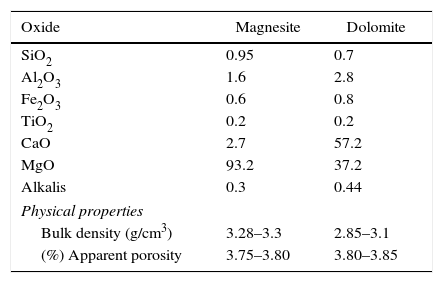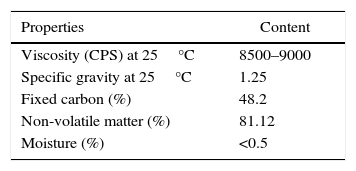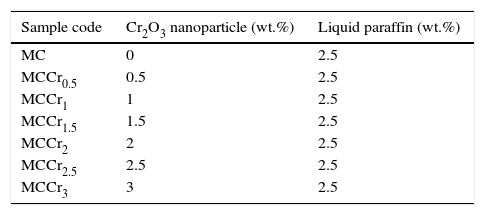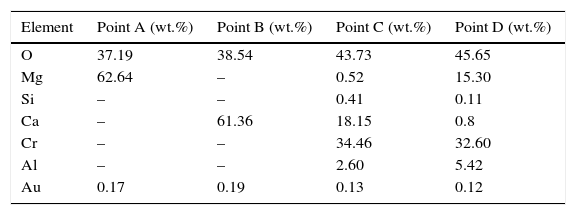At this study the effect of Cr2O3 nanoparticles (up to 3wt.%) on the physical and mechanical properties of MgO–CaO refractory composition with emphasis on the hydration resistance improvement have been investigated. Specimens pressed at 90MPa then were sintered at 1650°C for 5h in an electric furnace. Properties such as bulk density, apparent porosity, cold crushing strength and hydration resistance were examined. The crystalline phases and microstructure characteristics of sintered specimens were studied by X-ray diffraction (XRD) and scanning electron microscopy (SEM/EDS), respectively. Results shown that add of the 1.5wt.% Cr2O3 nanoparticles have the best results i.e. increased the bulk density (3.41g/cm3), cold crushing strength (848kg/cm2), hydration resistance (1.5%) and decreased apparent porosity (5.58%), respectively. The mechanism of specimens hydration resistance improvement are: (i) decreasing the amount of free CaO and MgO with converted to high hydration resistance phases such as CaCr2O4 and MgCr2O4 phases, (ii) promotion of the densification as well as (iii) modification of the microstructure.
En este trabajo se ha estudiado el efecto de la adición de nanopartículas de Cr2O3 (hasta un 3% en peso) en las propiedades físicas y mecánicas de refractarios de MgO-CaO, poniendo especial énfasis en la mejora de la resistencia a la hidratación. Las muestras fueron prensadas a 90MPa y posteriormente sinterizadas a 1.650°C durante 5h en un horno eléctrico. Se han evaluado propiedades tales como la densidad y la porosidad aparente, la resistencia a la compresión en frío y la resistencia a la hidratación. Las fases cristalinas y las características microestructurales de las muestras sinterizadas se han estudiado mediante difracción de rayos-X (DRX) y microscopia electrónica de barrido (MEB/EDS), respectivamente.
Los mejores resultados se han obtenido con una adición del 1,5% en peso de nanopartículas de Cr2O3, lo cual incrementa la densidad aparente (3, 41 g/cm3), la resistencia a la compresión en frío (848 kg/cm2) y la resistencia a la hidratación (1,5%), y disminuye la porosidad aparente (5,58%), respectivamente.
Los mecanismos de mejora de la resistencia a la hidratación son: 1) disminución de la cantidad de CaO y MgO libre mediante la conversión a fases altamente resistentes a la hidratación, como son las fases CaCr2O4 y MgCr2O4; 2) fomento de la densificación, y 3) modificación de la microestructura.
Magnesia–Doloma or Mag–Dol (MgO–CaO) refractory bricks have been considered as one type of chrome free refractories that are suitable for substituting the MgO–Cr2O3 refractories [1]. Typically, MgO–CaO refractory bricks composed by 50–80wt.% of MgO [2]. Different ways have been proposed to produce MgO–CaO refractory bricks. A new approach is using sintered and fused co-clinker of magnesite and dolomite as a starting material for the MgO–CaO refractories which would lead to more homogenous products with more desirable properties [3]. Another way is mixing magnesite and dolomite and calcination them at high temperature that let to in-situ MgO–CaO refractory brick [4]. These refractory bricks have been playing a crucial role as a refractory material in various industries such as secondary metallurgy (AOD, VOD, etc.), non-ferrous furnaces (copper converter) and cement making (rotary kiln) because of their great advantageous such as high temperature stability, low thermal expansion, excellent thermal shock resistance, outstanding erosion–corrosion performance at high temperatures, wide availability of raw materials, low vapor pressure, and thermodynamic stability in the presence of carbon in a composite oxide/carbon refractory [1–8]. Furthermore, MgO–CaO refractories are beneficial to removing inclusions from molten steels; thus, they have been considered to be one of the effective refractory types for processing clean steel products [2,4,9]. In recent years, with the increasing demands of molten steel purity, the awareness of environmental protection and resource shortage grows, MgO–CaO materials have become one of the attractive steelmaking refractories [3–6]. However, in spite of these advantageous properties, the application of MgO–CaO refractory bricks has not been popular due to their tendency to hydration when exposed to the atmosphere [1–5,10].
Recently, much effort has been made to improve the performance of MgO–CaO refractory bricks through the addition of different additives, such as V2O5[11], CuO [12], FeTiO3[13], La2O3[14], Ce2O [15], ZrO2[16], and Fe2O3[17]. It has also been reported that physical properties of MgO–CaO refractory bricks could be improved by using pitch, tar, flake, and vein graphite minerals [2–6]. Also the hydration resistance of MgO–CaO refractories can be improved by treating in a CO2 atmosphere or by surface phosphate coating which leads to the formation of a dense layer on the surface of CaO, and protect CaO grain from hydration [18,19]. Nanotechnology was introduced to the refractory industry some year ago, and nowadays it is an important tool included in many research projects [16,20–22]. Several research groups have been working on the addition of different types of additives in ceramic bodies, and some of them have focused their investigations on the use of nano-oxides, due to the reported benefits of adding these particles to ceramic bodies [23–26]. On the other hand, it is known that the fine fraction is considered to be the weakest constituent of a refractory matrix. Therefore, it has to be reinforced by the development of a strong bond. The bonding strength represents one of the main microstructural characteristics that contributes to the development of a reliable refractory matrix. Increasing the bonding strength, the resistance against many kinds of stresses during performance and structural spalling would be improved [25]. Taking the above into account, in the present research work, the effect of nanoparticles of Cr2O3 as structural bonding on the microstructure, sintering process and properties of MgO–CaO refractory matrix was investigated.
Experimental procedureThe raw materials used for preparation the batch composition of the MgO–CaO refractories specimens were calcined magnesite and dolomite (derived from Birjand and Zefreh mines in Iran, respectively), and the details of them are provided in Table 1. High-grade nano-Cr2O3 (supplier: US Research Nanomaterials, Inc. CAS Number: 1308-38-9) with an average particle size in the range of 50–60nm was used as additive (Fig. 1, Table 2). Also a liquid resin was used as binder and the details of it are provided in Table 3. Different compositions of MgO–CaO refractories specimens were formulated by varying nano-Cr2O3 content between 0 and 3wt.% with fixed CaO content of 35wt.%. Conventionally used MgO–CaO refractory (Batch MC) has also been prepared under similar conditions for comparison purpose and details of all the batches are provided in Table 4.
In order to obtain a suitable and stable suspension of nano oxides, a dispersion process was carried out using an acrylic copolymer (Zephrym PD3315) as a dispersant agent and acetone as a dispersion medium. The ultrasonic agitation method (Aqua sonic TM 75T model) was carried out for 1h for homogenization.
All the raw materials, additives and binders were thoroughly mixed in a pan mixer as per the batch composition and following the mixing sequences, as mentioned in Table 5, to obtain a homogeneous mixture. Mixed batches were aged for 1h and specimens with a diameter of 50mm and a height of 50mm were obtained using uniaxial press at 90MPa. Pressed refractory specimens were sintered in an electric furnace at 1650°C at a rate of 3°C/min for 5h, which removes volatiles, polymerizes the organic binders and imparts strength to the shapes. Different physical and mechanical properties of the sintered samples were evaluated. An average of five different individual test results is represented here in different plots as data point and discussed in the results and discussion portion. Apparent porosity (AP), bulk density (BD), and cold crushing strength (CCS) were measured as per the standard of is: 1528, part-8 (2002), is: 1528, part-12 (2002) and is: 1528, part-4 (2002), respectively. In order to determine the hydration resistance of the refractory specimens, each sample was powdered to gain a particle size finer than sieve no. 40 (425μm) and after weighing, placed in Petri dish in a climate room with 25°C temperature and 95% relative humidity. The samples then were weighed at different times to 72h. The percentage weight gains before and after hydration was the measures of hydration resistance Eq. (1).
M2, weight gain after hydration test; M1, weight of sample before hydration test.
The presence of ceramic phases was determined by X-ray diffraction technique (XRD; Bruker D8 Advance model) with CuKα radiation (λ=1.5406Å) operated at 40kV and 30mA. The scans were performed in the 2θ range from 10 to 110 with a step scan of 0.05 and 1.5s per step in a continuous mode. The microstructure analysis was performed using an FEI Nova Nano SEM 200 scanning electron microscope equipped with an electron dispersive X-ray spectroscopy (EDX) detector (EDAX, Apollo XP model, 2930 serial number).
Results and discussionPhase analysisFigs. 2 and 3 Shows the XRD patterns of the samples with and without Cr2O3 nanoparticles. Periclase (MgO) and lime (CaO) were the main crystalline phases in all the samples. Also, in the sample with 1.5% and 3wt.% Cr2O3 nanoparticles; MgO, CaO, CaCr2O4 and MgCr2O4 were the main crystalline phases. CaO and MgO reacted with Cr2O3 nanoparticles and formed CaCr2O4 and MgCr2O4, with melting point 2170°C and 2350°C respectively [26]. The aforementioned phases at the sintering temperature (1650°C) are in solid state. Also Cr2O3 phase peaks not exist. It indicates that all added Cr2O3had reacted with CaO and MgO to form CaCr2O4 and MgCr2O4 phases which preferred to locate on intragranular and intergranular sites of MgO and CaO grains. The intensity of the CaCr2O4 and MgCr2O4 phases peaks for samples contain more Cr2O3 nanoparticles (MCCr3) are higher than samples without (MC) or contain lower amount of the Cr2O3 nanoparticles.
Microstructure analysisFig. 4a shows the microstructure corresponding to the specimen without the addition of Cr2O3 nanoparticles. From the analysis, the typical microstructure of an MgO–CaO fractured surface is observed. In addition, porosity and a white gray phase corresponding to CaO (calcia) were identified as well as MgO (magnesia) particles (dark phase), identified by energy dispersive X-ray (EDX) (Table 6). The microstructure analysis by SEM corresponding to specimens with Cr2O3 nanoparticles additions is shown in Fig. 4b and c. A homogeneous microstructure composed mainly of a well-distributed phases is observed. Using energy dispersive X-ray spectroscopy analysis (EDX), dark gray phase was identified as MgO (magnesia) and white gray phase was identified as CaO (calcia). As a second phase, there are two phases surrounded by the periclase and calcia ground mass. The first one corresponds to light gray particles composed by Ca and Cr elements, as it was identified by EDS. This phase is a spinel compound found in the XRD analysis and identified as CaCr2O4. The last phase corresponds to bright gray particles composed by Mg and Cr elements (identified by the EDS technique), (Table 6). From the EDS and XRD analysis, this phase was confirmed as a spinel MgCr2O4. During the microstructural analysis, it was observed that CaCr2O4 and MgCr2O4 are homogeneously dispersed through the entire matrix. As the Cr2O3 nanoparticles content was increased, some coarse agglomerations composed by CaCr2O4 and MgCr2O4 were formed. This microstructural characteristic described above can be correlated to the diminished mechanical resistance at higher Cr2O3 nanoparticles content since CaCr2O4 and MgCr2O4 agglomerates could be acting as stress concentrates, thus making the matrix weaker.
EDX analyses of (1) A (CaO), (2) B (MgO), (3) C (CaCr2O3) and (4) D (MgCr2O4) points.
| Element | Point A (wt.%) | Point B (wt.%) | Point C (wt.%) | Point D (wt.%) |
|---|---|---|---|---|
| O | 37.19 | 38.54 | 43.73 | 45.65 |
| Mg | 62.64 | – | 0.52 | 15.30 |
| Si | – | – | 0.41 | 0.11 |
| Ca | – | 61.36 | 18.15 | 0.8 |
| Cr | – | – | 34.46 | 32.60 |
| Al | – | – | 2.60 | 5.42 |
| Au | 0.17 | 0.19 | 0.13 | 0.12 |
Bulk density and apparent porosity are the two important indicative parameters to ascertain the densification of a ceramic system [2]. The variation in bulk density and apparent porosity of the sintered samples fired at 1650°C for 5h with different amount of Cr2O3 nanoparticles have been shown in Fig. 5. It is observed that the bulk density begins to increase gradually starting from 0.5wt.% of Cr2O3 nanoparticles (3.1g/cm3), and finding its higher value at 3wt.% (3.41g/cm3). This behavior can be attributed to:
- (i)
A better compaction of the body on filling up of the intergranular voids between MgO and CaO grains.
- (ii)
A better sintering of the refractory body due to the presence of fine/reactive nano-Cr2O3 phase.
- (iii)
The higher true density of Cr2O3 (5.22g/cm3) [26], in comparison to the CaO (3.35g/cm3) and MgO (3.58) [3–5] or maybe because of a possible new phases formation [such as MgCr2O4 (4.43g/cm3) and CaCr2O4 (4.43g/cm3)] [26,27].
- (iv)
And Cr2O3 nanoparticles alter the grain boundary between assemblage and the morphology of the grains, changing the dihedral angle (θ). The lowering of the dihedral angle means ϒss will be smaller, which will facilitate grain-to-grain contact and ultimately direct bond formation. This tendency increases the densification [2].
But the apparent porosity tendency shows that it values decrease with increasing Cr2O3 nanoparticles content up to 1.5wt.% and for further spinel Cr2O3 nanoparticles (2 up to 3wt.%), the apparent porosity increased. The reason is:
- (i)
Due to large differences in thermal expansion coefficients between MgO (∼13.5×10−6°C−1) [5], CaO (∼13.8∼×10−6°C−1) [5] and MgCr2O4 (∼8.5∼×10−6°C−1) [26], it can generate excessive micro-cracks formation in the microstructure, provoking a porosity increment.
Fig. 6 shows the variation of the cold crushing strength of the MgO–CaO refractory compositions with addition Cr2O3 nanoparticles. The values of the CCS, registered by the refractory specimens containing Cr2O3 nanoparticles, were much higher than those determined by the specimens without nanoparticles addition. A sharp increase in the strength value is obtained with addition Cr2O3 nanoparticles up to 1.5wt%. The maximum CCS was found for the MCCr1.5 specimen (348kg/cm2). It was observed that higher Cr2O3 nanoparticles concentrations (from 2 to 3wt.%) decreased the CCS of the MgO–CaO refractory compositions.
This mechanical tendency may be attributed to the following phenomenons:
- (i)
A good compactness induced by the Cr2O3 nanoparticles.
- (ii)
The low apparent porosity registered (for MCCr0.5, MCCr1 and MCCr1.5 samples).
For MCCr3 formulation corresponding to 2 up to 3wt.% of Cr2O3 nanoparticles, there is a gradually decline in mechanical properties. This phenomenon can be explained due to the formation of coarse agglomerates and a large thermal expansion coefficient (MgO=∼13.5×10−6°C−1, CaO=∼13.8×10−6°C−1, MgCr2O4=∼8×10−6°C−1) miss-match between different phases presented in the refractory bodies. The different thermal expansion coefficient between phases leads to the formation of peripheral micro-cracks around agglomerates; these micro-cracks could be a detriment to mechanical performance, as can be observed in the plot of Fig. 6.
Hydration resistanceRefractories based on MgO and CaO can undergo hydration in humid atmosphere. In this case the powder grains break, the material is pulverized, and particles crack [8,11,13,14]. Several methods have been tested to control this phenomenon, including methods through which CaO and MgO grains are covered by phases grow in the grain boundaries and those through which the porosity of the system decreases; all methods lead the accession of CaO and MgO to the moisture to decrease [1–4,7,11,14]. From Fig. 7 it is observed that the mass gain of MgO–CaO specimens decreased appreciably with Cr2O3 nanoparticles addition. For sample without addition, the mass gain after 72h was 2.95, which was gradually decreased with increasing the amount of Cr2O3 nanoparticles. The degree of hydration is related to the absorption of water on the grain boundary surface. It is known that the hydration resistance of CaO contains materials, both rich-CaO and rich-MgO materials, which is strongly dependent on the content of free CaO in materials and its microstructure [5,16]. When Cr2O3 nanoparticles were added, the promotion of the hydration resistance of the refractories is considered due to the following reasons:
- i.
The promotion of densification by the addition of Cr2O3 nanoparticles decreased the porosity of the refractories and thus its active specific area was decreased while the refractories were exposed to a humid environment.
- ii.
by increasing the addition of Cr2O3 nanoparticles, the content of free CaO and MgO in refractories decreased further (because of convert free CaO and MgO to CaCr2O4 and MgCr2O4 phases that are better hydration resistance rather than CaO and MgO) and thus the hydration resistance of refractories was improved.
- iii.
It is well known that the hydration reaction always begins from the sites with crystal defects [2,5,16]. Thus, the grain boundaries, especially the triple points, are the poor hydration resistance sites. When Cr2O3 nanoparticles was added, they formed phases such as CaCr2O4 and MgCr2O4 located at grain boundaries and the triple point of CaO and MgO grains, thus preventing the hydration resistance of the MgO–CaO specimens.
The main notice in reactions (2) and (3) is the formation of calcium or magnesium vacancies. In reactions (2) and (3) these vacancies formation affects the calcined powders by forming new surfaces, because of the role of the electrostatic repulsion force between anions in vacancies, thus increasing the surface energy and promoting solid reactions and the sintering process. These effects increase the powder density, so as to increase the hydration resistance of MgO–CaO refractories. In terms of a preference of cations to form a solid solution with CaO and MgO, improvement of the hydration resistance of the CaO–MgO via a reduction of the Ca2+ and Mg2+ concentration in the solid of CaO and MgO with Cr3+cations was favored.
Conclusion- •
The addition of Cr2O3 nanoparticles helps in improvement of the densification process by solid state sintering mechanism. A maximum density of 3.41g/cm3 is achieved at 1650°C in presence of 3wt.% nano-Cr2O3.
- •
The high cold crushing strength of Cr2O3 nanoparticles doped CaO-MgO specimens is due to the development of a strong and continuous bonding structure.
- •
The addition of Cr2O3 nanoparticles leads to the high solubility of chrome oxide (Cr2O3) in calcia (CaO) and magnesia (MgO) that leads to the formation of cationic vacancies in calcia and magnesia, resulting in a high atomic mobility, encouraging the precipitation and enhancing the direct bond formation.
- •
The addition of 1.5wt.% of Cr2O3 nanoparticles contributed to reach a maximum increment in physical and mechanical properties.
- •
In general, for the purpose to improvement the hydration resistance of the MgO–CaO refractories, the addition of Cr2O3 could be more effective by nano-technology due to its intrinsic properties such as significant surface effect, size effect and higher activity.





























